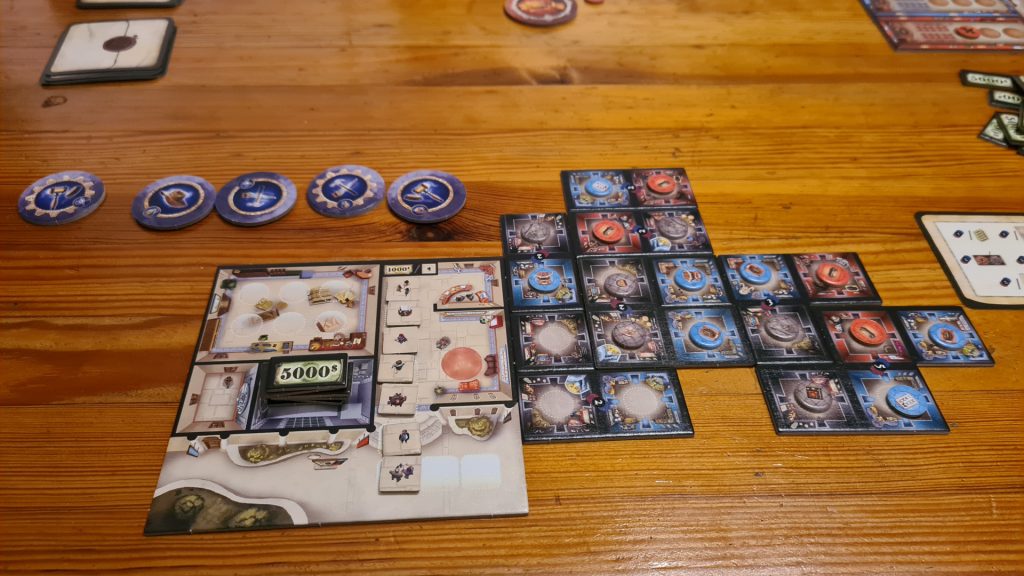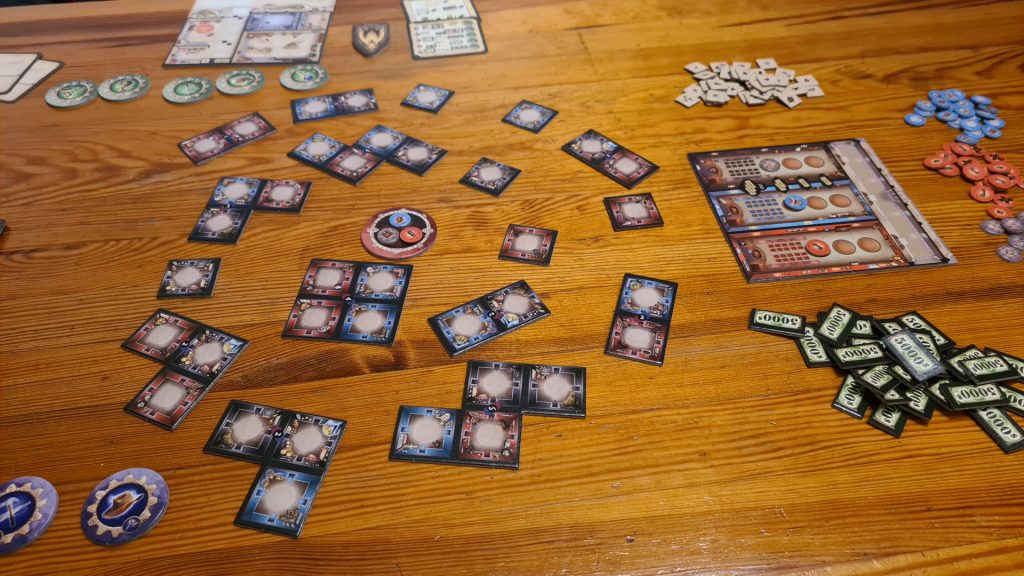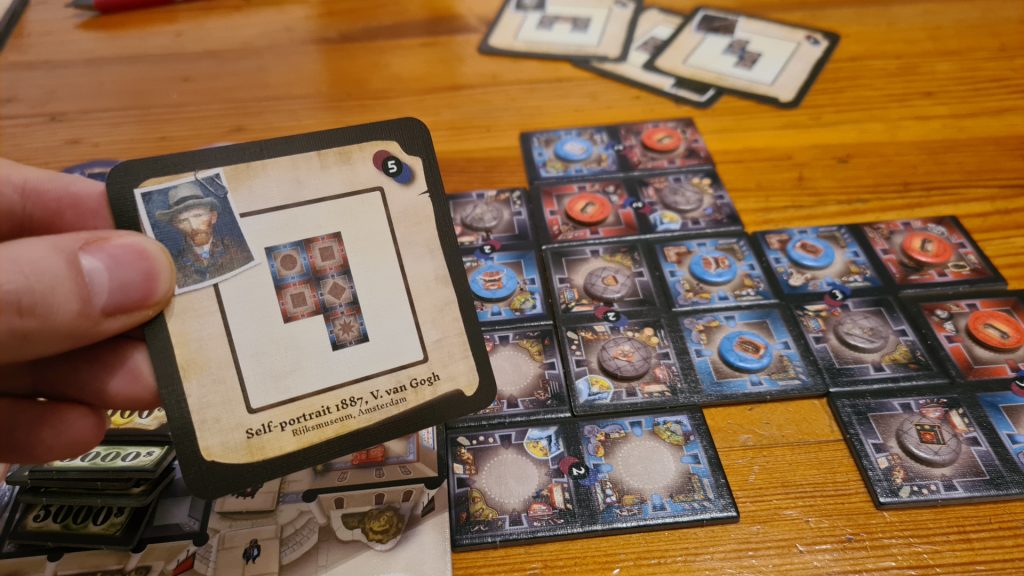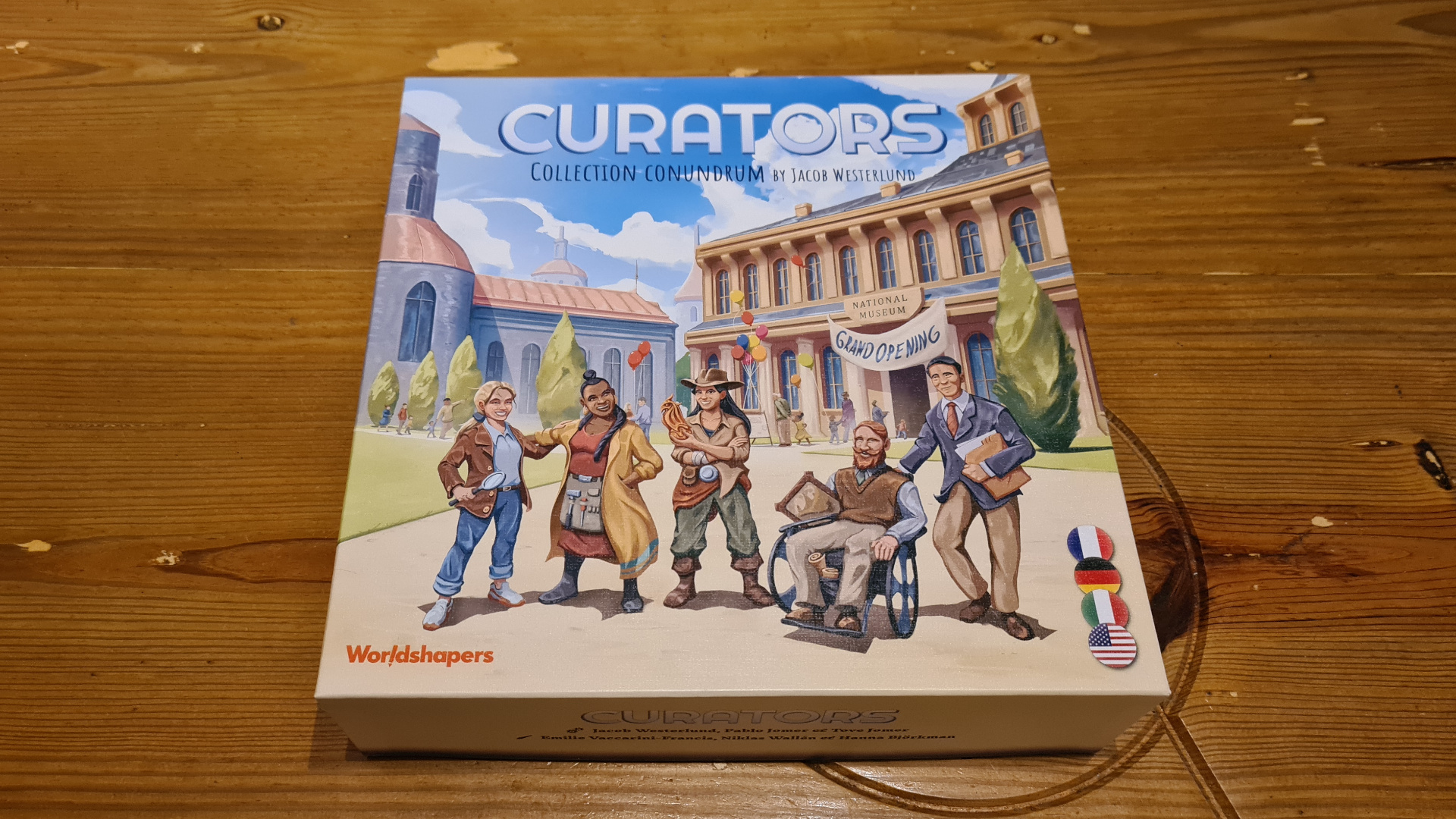Curators is the brand new museum themed tile placement and pattern building board game, from publishers Little Rocket Games and Worldshapers. Designed by Tove Jomer, Pablo Jomer and Jacob Westerlund, the game sees 1 – 4 players becoming… curators. Tasked with growing their museum by building new wings, gathering objects to then display and fulfilling objectives players will need the help of their employees. However, will the game be found gathering dust or be on show as the pride of the shelf? Let’s find out!
Setup is relatively simple, with each player taking a museum board, $4,000 from the bank, a visitor token, two objective cards and a set of 5 action tokens. Building a spiral of tiles in the middle of the table, with the number of tiles depending on the player count, the game end token is placed at the center of the spiral. Adding, off to one side, piles of the three coloured object tokens and the market board, the game is ready to begin.
On a turn the active player chooses one of their 5 tokens, performing the action denoted and flipping it over. If the player has two tokens showing the same icon they can instead choose to flip both and perform a double action. There are a number of different employees the player can activate on their turn, from carpenters to financial managers. Choosing the carpenter action sees the player taking a tile from the spiral and adding it to their museum – adjacent to a door on their museum player board or an already placed tile.

Importantly, every tile in the spiral is available, if the player can afford it. The first tile of the spiral is free with each tile skipped over adding $1,000 to the cost. Taking a double carpenter action sees the player gaining two tiles, both based on their price at the start of the turn. Each wing is made up of at least 1 room and each room on a tile has a colour. As you build out the patterns made by rooms will be important for scoring objective cards and what colour objects they need to be filled.
There are two ways to obtain objects for your museum. The archaeologist action sees you take two object tokens of any colour and add one to the market and one to your museum’s storage. Doubling this action sees the player take objects of two different colour – again adding matching tokens to the market. Unsurprisingly, the second way to gain objects is via the market. Players can go to the market to pay for objects via the collection manager action, with the price based on the number of that colour object available on the market tile. Note that only one colour of object can be brought, but as much of it as you can afford. Doubling the action results in the player purchasing objects of two colours, with a minimum of 1 of each.
With empty museum rooms and objects in your storage it’s time to display them via the restorer action. This action allows the player to place as many objects of any one colour to matching empty rooms in their museum, with the double action allowing any objects of two colours to be placed. Each time you fill a wing of rooms with objects your museum gains a visitor. Every few visitors players can take an additional objective card. These award points at the end of the game if completed. Featuring a layout of rooms with distinct colours these rooms will need to be in the same configuration and have an object in them for the points to be awarded. Visitors will also gain the player $1,000 each when the financial manager action is taken, with a simple doubling of this action possible.

So, on a turn the active player will perform an action and then play proceeds clockwise around the table. The end of the game is triggered when all of the room tiles have been claimed, with the player that took the final tile gaining an object of any colour for free. At this point all players get two final turns before points are calculated. Via filled wings of rooms, objective cards and unspent money players determine who has the most points, with them being deemed the best of the Curators – with ties split by remaining money.
There is a bit of a thematic disconnect between how some of the actions work and what you’d expect. For example, the financial manager action gains the player money for each visitor token in the player’s museum but that same visitor token can again later hand over more money, as if the museum is some kind of highway robbery slowly dwindling the cash of its patrons. It may have even made more sense for the archaeologist action to be pulling tokens blindly from a bag, giving the collection manager more of a different feel.
The way that players must plan ahead their actions creates a variety of interesting choices throughout Curators. Taking an action guarantees that token to be flipped and therefore, without a second token showing the action, means it won’t be available for at least the next turn. Not only does this mean players need to plan their actions, opportunities can arise or be completely missed. For example, there could be an ideal tile just outside of your reach from the central market. If a player or two before you buys closer tiles then the one you want suddenly becomes cheaper. If you don’t have a token showing the carpenter action though then that opportunity could pass you by as someone else snaps it up.

Players can somewhat trend towards one action over others. If you can get a lot of visitors then repeatedly triggering the financial manager action can be extremely beneficial for example. Still, due to the way actions are taken and then flipped, players must to some extent always do a bit of everything. This means that you cannot try in one game to exploit one action and in the next not even touch it. This doesn’t result in every game feeling 100% identical, though not being able to specialise your path to victory seems like a missed opportunity.
Production wise Curators is generally strong. The player board, which is effectively your museum entrance, has the space for objects, money and visitor tokens. The double sided action tokens helpfully show what they will become when flipped, so there’s no need to keep peaking at the other sides for planning ahead. Cardboard chits are used for the money, which come in a couple of denominations. The rooms have some details to them, though it would have been nice to see more to distinguish the three rooms above colour – be that room shape or such. At the end of the game though players can look down and see a top down view of their museum with visitors queuing to get in.
Curators combines action selection with tile laying and is as much about the surrounding elements of the museum, the objects on show, as the patterns and layout of your museum. When playing the game constantly pulls players one way and another, so you get to do a bit of everything. There are some opportunities though to exploit the action tokens for those bigger double turns though, and this is where players can have those bigger than normal turns, giving that extra thrill of pulling off more than normal.
For all of this, Curators can feel a bit samey from one game to the next, not identical but not vastly changing. This isn’t as damning as it could be there is the choices to be made and the game doesn’t outstay its welcome. Just a bit of extra variety, such as a shake up to the abilities of the collection manager and archaeologist, could have made it hit the table more.
(Editor’s Note: Curators was provided to us by Asmodee for the review. The game is currently available from local board game stores! Find your local store here.)

